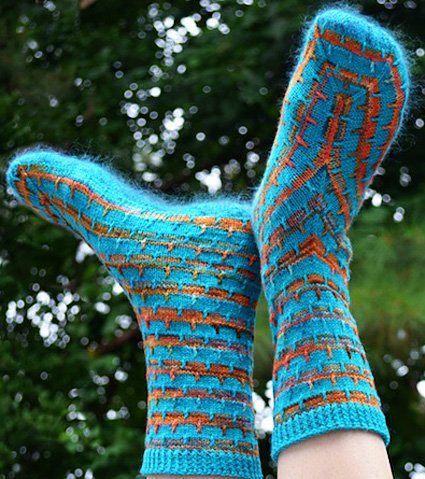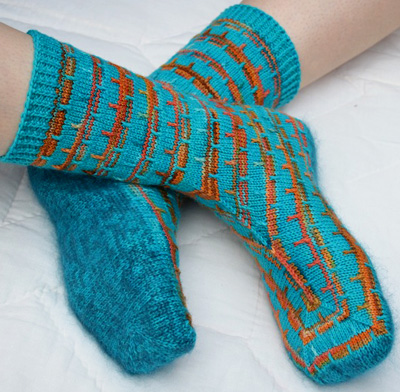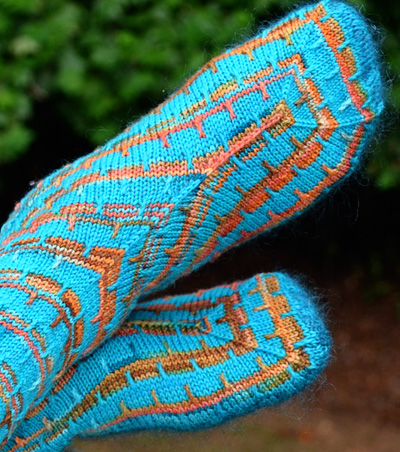

|
|
|

My friend's Grandma Bea always knitted socks with stripes. She said they went faster, because instead of saying to yourself "I'll just finish this round," you say "I'll just finish this stripe," and before you know it, you're done. These are really just simple striped socks, but they're unlike any that Grandma Bea ever made. That's because the sole is knitted in full first, before all the rest of the sock. I developed this method so that I could easily reinforce my sock soles where they used to wear out: at the ball of the foot and sometimes the bottom of the heel. Right where the rubber meets the road, so to speak. For reinforcement yarn I carry along a strand of fine mohair/silk blend on the full sole -- it's both effective and hedonistically luxurious. A most happy discovery, as I carried on knitting up all around the full sole, was that the toe-shaping decreases caused even simple horizontal stripes to reinvent themselves in interesting ways. They turned corners around the toe and met in chevrons at the instep. I could make the toe and instep decreases complement stitch patterns in various ways and have the complete sock top as an unbroken design canvas. Endlessly intriguing design possibilities! This stitch pattern evolved as I experimented with making the stripes a little less stripy. I carried single stitches at intervals on up into the next color stripe by wrapping them three times, then slipping them knitwise on the next three rounds. That way they get twisted three times in the same direction, which makes them stronger and more textural. |
||
|
SIZE |
|
|
FINISHED MEASUREMENTS |
|
MATERIALS Notions |
|
GAUGE |
| 32 sts/40 rnds = 4 inches in stockinette stitch (MC and reinforcement yarn together) 35 sts/48 rnds = 4 inches in pattern stitch on sock top |
|
PATTERN NOTES |
|
CDD: Central Double Decrease. Slip 2 tog (as if to k2tog), k1, then pass 2 slipped sts over stitch just knit. Judy's Magic Cast On, bottom-needle-first variation:
Half-Twist Ribbing (Multiple of 2 sts, worked in the round):
|
|
DIRECTIONS 
Needle 1: K1, m1, k1, pm c1 for end of heel, k41[45, 49], pm c2 for beginning of toe, k3. Needle 2: K1, m1, k1, pm c2 for end of toe, k41[45, 49], pm c3 for beginning of heel and start of round. 3 sts rem unworked from CO at this point. Note: It's easiest if you keep the sts arranged as they are, with the first three sts of the round on the same needle as the last sts of the round. There are 6 heel sts, 6 toe sts, and 41[45, 49] sts on each side. 94[102, 110] sts total. Next round: Work Sole Heel Chart to marker c1; k to marker c2, work Sole Toe Chart to next marker c2; k to end of round.  Row 9a [RS]: Work Sole Heel Chart row 9 to marker c1; k to marker c2, work Sole Toe Chart to next marker c2; k8, w&t. Row 9b [WS]: P8, work Sole Toe chart row 9b to marker, p8, w&t. Row 9c [RS]: K8, work Sole Toe chart row 9c to marker, k to end of round. As this point you will resume working in the round. Final sole round: Removing markers as you go, adjust st count for sock top as follows: Foot Note: You might find it helpful to put removable stitch markers in the CDD sts, to help you keep track. Work as set until Toe Shaping Chart is complete. 8 sts between Toe Shaping markers. Final Toe Shaping round: Work Main Patt chart 9[10, 11] times to marker, remove marker (CDD, k1) twice to next Toe Shaping marker, remove marker; work Main Patt chart 9[10, 11] times. 112[124, 136] sts rem -- 4 between Toe Shaping markers. Next round: Work 42[47, 52] sts in pattern as established.  Drop working yarn and slip next 13[14, 15] sts to right needle. [If using circular needle(s), don't pull sts on RN to the cable yet.] Slip next 14[15, 16] sts to DPN (you're going to use it as a temporary left needle). Cut a separate strand of CC1 yarn about 18 inches long. Leaving a 4-inch tail, k2tog (the first two sts from the DPN) with the separate strand, then pass 2nd st on right needle over st just made. Slip that st back to LN without turning it. Then continuing with the separate strand, make a "zip line" up the foot as follows: [Slip the first st from right needle to left needle; work a CDD on the left needle; slip st just made to left needle] 12[13, 14] times. Slip the next st from right needle to left needle, drop the separate strand, pick up the CC1 working yarn, and work one final CDD. And then finish round, working 43[48, 53] sts in pattern as established. Total 86[96, 106] sts remain. Instep Note: If any sts needed for the CDD are on RN, reposition them to LN (without twisting them), then do the CDD. Decrease round: Work in pattern as set to 1 st before the marked center st; CDD; work in pattern as set to end of round. For a Shaped Leg, work even in pattern as set, working Main Patt chart 11[12, 13] times around, until sock measures 5.5[6, 6.5] inches above sole. Increase rnd: K1, M1B, work to 1 st before end of rnd, M1F, k1. Continue working even in pattern as established for about 1 inch or length desired to cuff, ending with Chart round 5 or 10. Cuff Bind off using Jeny's Surprisingly Stretchy method. |
|
FINISHING |
| ABOUT THE DESIGNER |
|
|
|
Pattern & images © 2014 Betty Salpekar. Contact Betty |